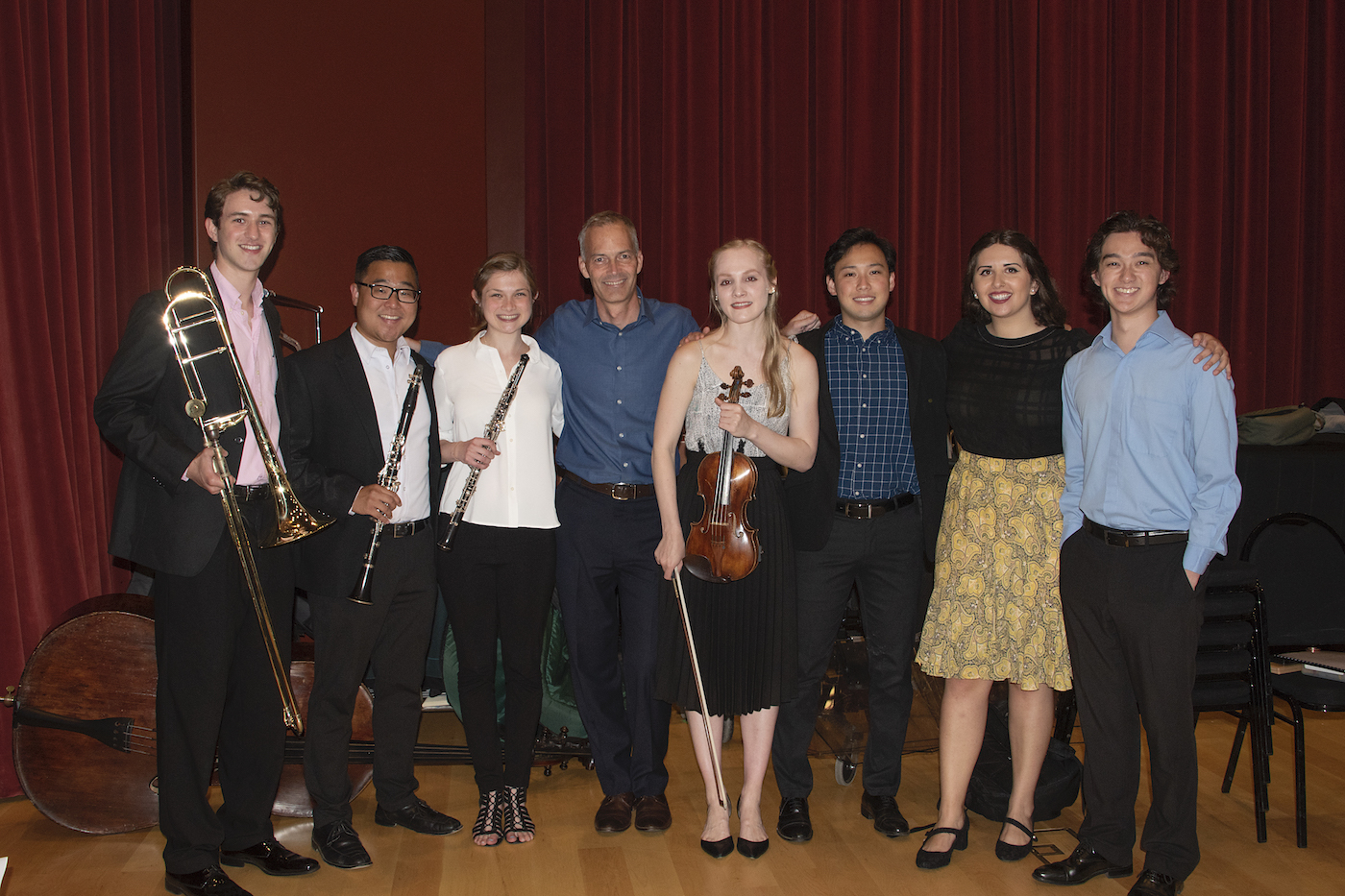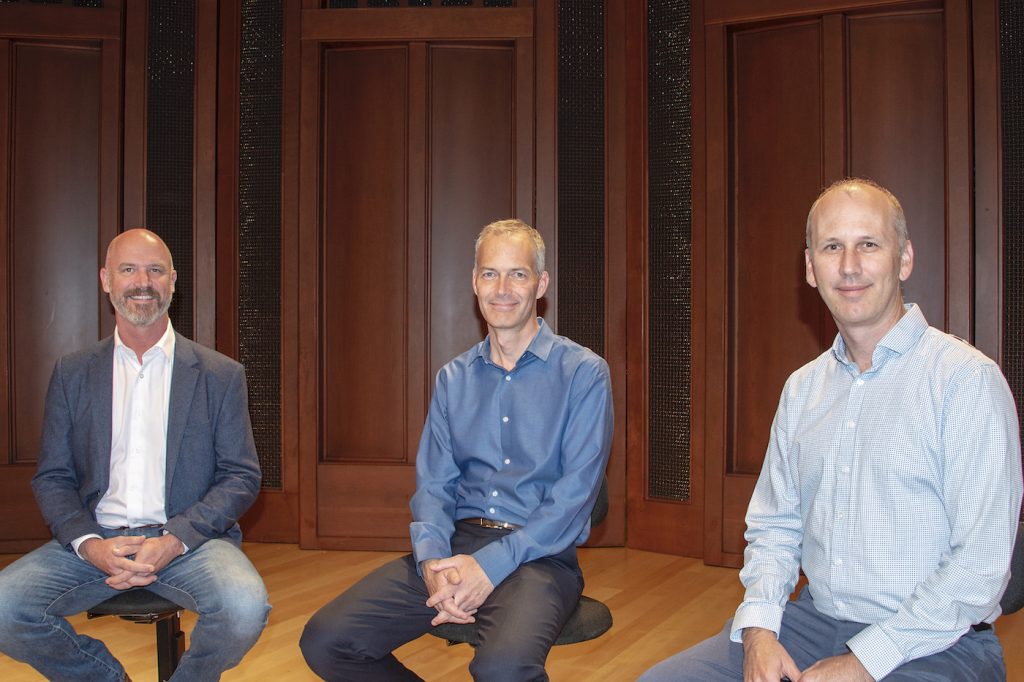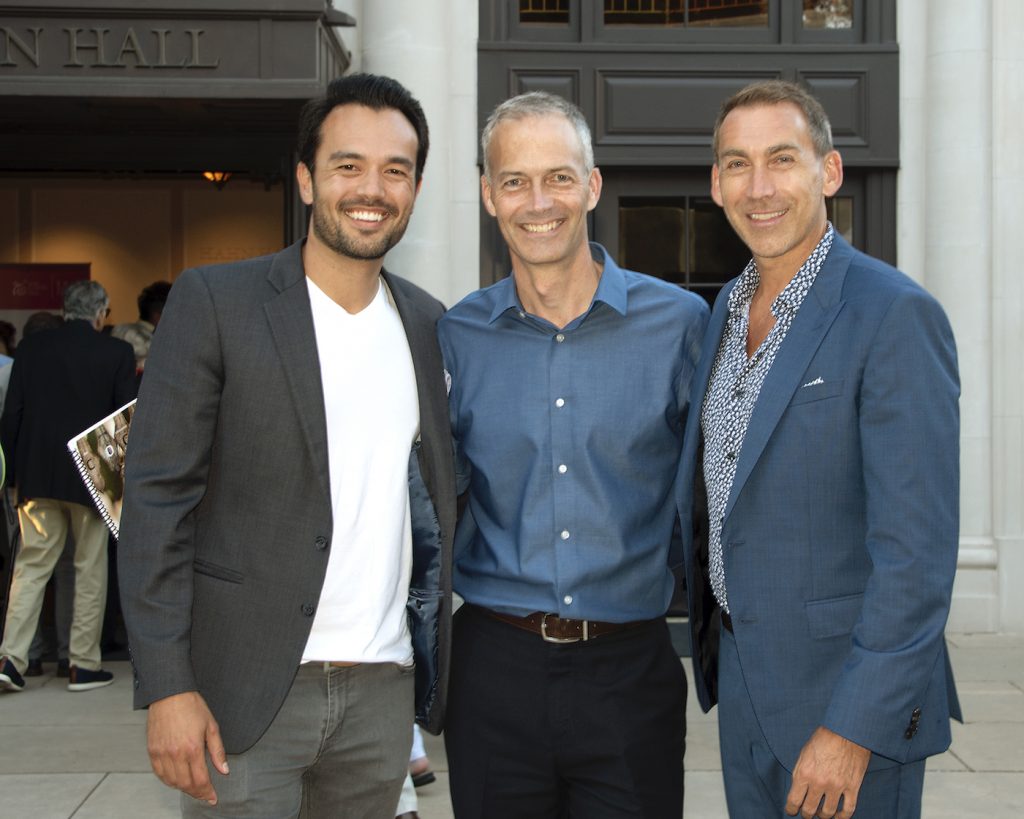In Concert with The Squire Foundation with NCEAS & the Music Academy of the West

The “Cocoon” world premiere arrived in a sold-out concert on July 19 at the Music Academy of the West (MAW) Hahn Hall, as part of the MAW Fellows “Picnic Concert Series.” The guest artist composition titled “Cocoon,” by Jim Stephenson, is a trifecta Artist in Resident project which started July 2018 incorporating science, music, and art. It is sponsored by the UCSB National Center for Ecological Analysis and Synthesis (NCEAS) with Ben Halpern,PhD, UCSB marine scientist, and executive director of the MAW and the Morris Squire Foundation (MSF).
Stephenson, currently a Chicago-based music composer and conductor, is an alumnus of MAW, which he attended in 1988 and 1991 as a trumpet fellow. He joined MAW at the 2018 Summer School and Festival as a composer-in-residence with support from the MSF. Ashley Hollister, MSF Executive Director, said, “Jim’s music was composed in part at the Squire Foundation’s baby-grand piano, and we are thrilled to see this very special work come to fruition. Squire is very proud to work with these two incredible local institutions, the Music Academy of the West and NCEAS, both of which are leading examples of world-class music programming and innovative scientific research. Our arts-music-science collaboration concurs with Getty Trust President Jim Cuno‘s statement, ‘What we today recognize as art and science sprang from the same origins – a shared desire to explore and explain the universe in all its dazzling diversity.’ And we couldn’t agree more.”

The MAW event started with Ben and Jim’s pre-concert lecture, moderated by scientist-musician Will McClintock, PhD. Jim explained the piece has three core movements, the opening where all the instruments are talking at once like the scientists sitting around a table, then each musician plays a solo leading into the finale where all join, similar to what he said he observed at NCEAS.
The concert program commenced with the classical Schubert Quintet in A Major, D. 667, “The Trout”; followed by Wonju Lee “Yeon” a traditional Korean piano and mezzo soprano work; and the lively Strauss’s “Till Eulenspiegel – einmal anders!” arranged by Hasenohrl. All the musicians were impeccable and on point.
Following intermission, Stephenson conducted his 13-minute composition “Cocoon,” by a seven musician ensemble of Emma Carleton violin, Alexander Lee Agate piano, Anne Pinkerton oboe, Roy Park clarinet, Ethan Shrier trombone, Anya Garipoli harp, and David Yongsoo Yoon percussion and tombak. Here is an interesting ensemble of instruments that performed equally well together and soloing, regardless of intentional scripted dissonance. The opening movement was a wall of sound high tonal range oriental fantasy themed movie, which abruptly dropped off into a brief silence as Yoon was switching from his kit to the tombak. His was a drum solo McClintock composed and sent to Stephenson. Being a middle eastern instrument, we were expecting the traditional model of Issam Houshan percussion, but the piece held onto single zoning repetitive patterns. Yoon’s technique is clean and perfected nonetheless. The piano solo was lively and full like a version of Aaron Copland’s “The Young Pioneers,” and only briefly touching a not full jazz bent with a flat key change. The clarinet, oboe and trombone solos were in synch and very trad. The violinist provided a commanding low-key melodic solo, bringing in the harp, which was too quickly rejoined by the entire ensemble for the finale. Though playing as a group, each instrument played full force in their own world, brought into a full monty faux-ending, stopped and then onto the “big-bang” up-volume ending, of which there were no tympanic drums, but the trombonist filled the roll well. In sum, though not at the level of Mason Bates “Mothership” or Angelica Negron’s award winning progressive composition, “Bubblegum Grass Peppermint Field,” it proved to be a progressive out-of-the-box work for the composer and the scientist.
The concert finished with the moody fantasy trio Schumann’s, “Fantasiestücke, Op.73” and the varied dance melodies of Bartók’s “Contrasts.”

Keynote attendees at the concert were Aaron Clark, CFP, AAMS Founder & President Monarch Wealth Strategies and member of the MAW Compeer Committee, and Paul Merkelo, Chair Trumpet with the Montreal Orchestra and teacher at the MAW.
I interviewed Ben and Jim briefly:
Q. Ben, NCEAS initiated Jim’s residency?
A. Yes, the idea was hatched at NCEAS because a friend of mine and resident at NCEAS – Will McClintock – has known Jim for a while and also has connections with folks at MAW, where Jim has had a professional relationship. It seemed like an exciting and natural fit to see if NCEAS and MAW could co-sponsor Jim’s residency with The Squire Foundation who also partners with the NCEAS’s artist in residence program.
How did the NCEAS scientists become involved in Jim’s work?
Jim’s residency was structured to allow for a lot of one-on-one interactions between him and the resident scientists. How that happened and evolved was fairly organic. I explained to Jim what we do at NCEAS, how our scientific teams operate and how I perceived them being similar to how chamber orchestras work, but the rest was up to Jim to explore and discover, and for the scientists to have a chance to see how a composer’s creative process works.
Jim, how and why were the instruments chosen for the composition?
The instruments chosen were based on the interviews of the scientists I conducted last summer. The instruments were either played by a scientist during their childhood, or I thought the instrument would best represent their personality, so the Tombak – Will McClintock; Clarinet – Ben Halpern; Piano – Halley Froehlick; Oboe – Geoff Willard; Trombone – Casey O’Hara; Violin – Jenny Siefert; and Harp – Grace Goldberg.
Jim, talk about science and music and this piece.
The idea of synthesis and collaboration, very similar to chamber music: having an idea, and someone else commenting on it, and a new idea forming – this is very similar to how musical rehearsals and performances work. “Cocoon” travels through many keys. It begins and ends in G minor, I suppose. But the work is not formal in that respect. It goes where it needs to go.
411: The National Center for Ecological Analysis and Synthesis, or NCEAS, is a research center affiliated with UC Santa Barbara that conducts transformational science to inform solutions that will allow people and nature to thrive. It accelerates discoveries by enabling interdisciplinary collaborations and the synthesis of data and ideas that shed light on the big picture of complex environmental challenges. www.nceas.ucsb.edu
Founded in 1947, The Music Academy of the West advances the development of 21st-century, classically trained musicians and cultivates discerning, appreciative, and adventurous audiences. Its world-renowned eight-week Summer Festival features nearly 200 events. Programs comprise voice, vocal piano, collaborative piano, instrumental, and solo piano. In 2018, the Academy launched a four-year partnership with the London Symphony Orchestra, focusing on education and performance on both sides of the Atlantic. www.musicacademy.org
C) At the “Cocoon” premiere with its composer Jim Stephenson, and from left, Aaron Clark and Paul Merkelo







